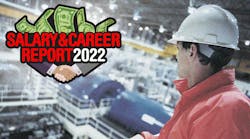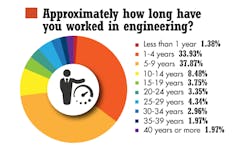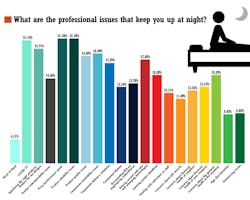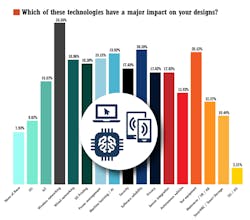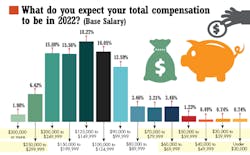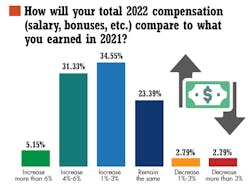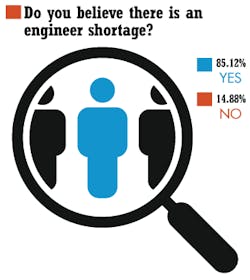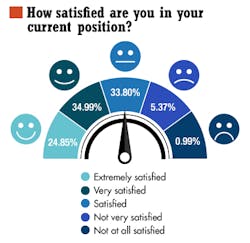Past surveys have tended to skew toward experienced workers. In 2021, for example, 59% of respondents were over the age of 50. In 2022, 71% of the respondents have been in engineering less than 10 years and 84% are under the age of 45. Their educational experience also is somewhat different—while 28% have a bachelor’s degree and another 30% possess a post-graduate degree, 22% have an associate’s degree and 18% have attended college.
Despite the demographic differences with past survey groups, their outlook on engineering and manufacturing in a post-pandemic, economically challenged world is largely the same. They see great value in their work and in the field of engineering, they recognize the challenges of staying current with the swift adoption of digital technology and their performance concerns center on product reliability, quality and customer service.
READ MORE: How do We Shape the Future Workforce?
Facing the Challenges
Survey respondents cited a wide array of business and professional challenges in the past year. While no one issue dominated the survey, the top concerns were focused on product reliability and the value of their finished products. The lingering COVID-19 pandemic and finding the right product to specify for their designs were also among the things keeping engineers up at night.
One overarching comment from respondents was the issue of time. A respondent said his challenge was “getting the adequate amount of time to get future-proof design knowledge and the willingness of management to learn and innovate and invest into technology.”
The adoption of technology has been a major issue in the fluid power industry, and implementing those innovations is another challenge of both time and available skills. One respondent noted the challenge of “finding the time to educate, improve, stay current while still performing all my work duties and maintaining work-life balance and supporting my family.” Another noted the “constant additional high amount of time and work parallel to ongoing tasks and prioritization of tasks.”
Technologies which are impacting designs were wide ranging with wireless networking as the only one which approached 25% among survey respondents. Test equipment and software reliability were cited by at least 20% of respondents, and machine learning, power management and wired network were next on the list. One anomaly among the Power & Motion survey results that reflects on the younger skew of this year’s survey: the recognition of augmented reality and the emerging concept of the metaverse. It was cited by 12.5% of engineers—more than four times higher than any other result from similar surveys conducted by sister publications to Power & Motion within Endeavor Business Media’s Design & Engineering Group.Read results from our colleagues in the Design & Engineering Group
Machine Design - Keeping Up: Survey Hears from Engineering on Skills Competency
Electronic Design - Engineers are in High Demand. Most are Not Missing the Opportunity.
Microwaves & RF - 2022 Salary & Career Report: Continuing Education
That was reflected in the comment of one respondent: “The increasing depth of engineering knowledge and ease of using recent technologies would require tech savviness,” he said. “There are at least three approaches to measure tech savviness: assessing what a person knows, what a person does (or reports doing), and what a person feels (attitudes, especially tech savvy self-assessments).
“Generally, this would mean more training on hands-on experiences which is, more often than not, time consuming as well as money consuming,” he added. “These efforts definitely have to be rewarded for any organization to attract good hands and meet up with the current technological demands.”
Compensation and Recruitment
With a more diverse group of respondents, the levels of compensation in the 2022 Salary & Career Survey also demonstrate a wide range. A year ago, 46% of engineers reported a salary between $100,000 and $150,000; in 2022, that number fell to 34%. But salaries above that level rose to 40% of respondents, and 16% were between $80,000 and $100,000.
The upward pressure on salaries driven by the continuing shortage of engineers is evident in respondents' views on future compensation. Salaries will continue to rise in 2022, with 71% of respondents expecting some sort of salary increase, and almost 37% expect that increase will exceed 4%. The engineers also feel well-appreciated for this work; 87% said they are adequately compensated for the work they do, and 95% declare themselves satisfied with their profession.
Finding the engineers to continue industry growth remains a challenge. The survey found:
- 85% believe there is an engineering shortage.
- 83.8% said their company is having difficulty finding candidates for engineering jobs.
- More than half of companies said they are seeking engineers with about 3 years of experience, and another 41% are looking for about 5 years of experience.
- Engineering companies are seeking a diverse group of engineering specialties. Mechanical design and power management are the most sought after specialty, but technologies from software to machine learning to safety and security are needed as well.
Continuing Education
In the past, the challenge of staying current with technology traditionally meant attending trade shows to scope out new products and participate in seminars to get more information about innovative technologies as well as partake in continuing education at universities or events.
READ MORE: Trade Shows Still Provide Business Value
The pandemic changed the equation.
Remote sources of learning and information are in wider use among engineers in a digital age, and those resources gained even more acceptance during the pandemic. Engineering videos, white papers, webinars and seminars all were cited by at least 25% of respondents as a source for continuing education. Other in-person events, such as in-person trade shows or user group meetings, fell back during the moratorium on travel and in-person events.
In the interim, more than 35% of respondents said their company paid for registration at online trade shows, more than 28% pay for engineering association dues and engineering textbooks, and 26.6% have paid for college tuition.
That interest in continuing education comes at a time when engineers recognize the need to continue to adapt their knowledge to changing technology. “A lot of engineering industries adjusted to the decrease in demand during the pandemic and are now going back to full operation,” said one respondent. “With that, they have the opportunity to either continue to use the same technology or venture into new ones.”
That quest will continue, added one respondent, “because human progress will never stop, and human progress will never happen without progress in engineering.”
